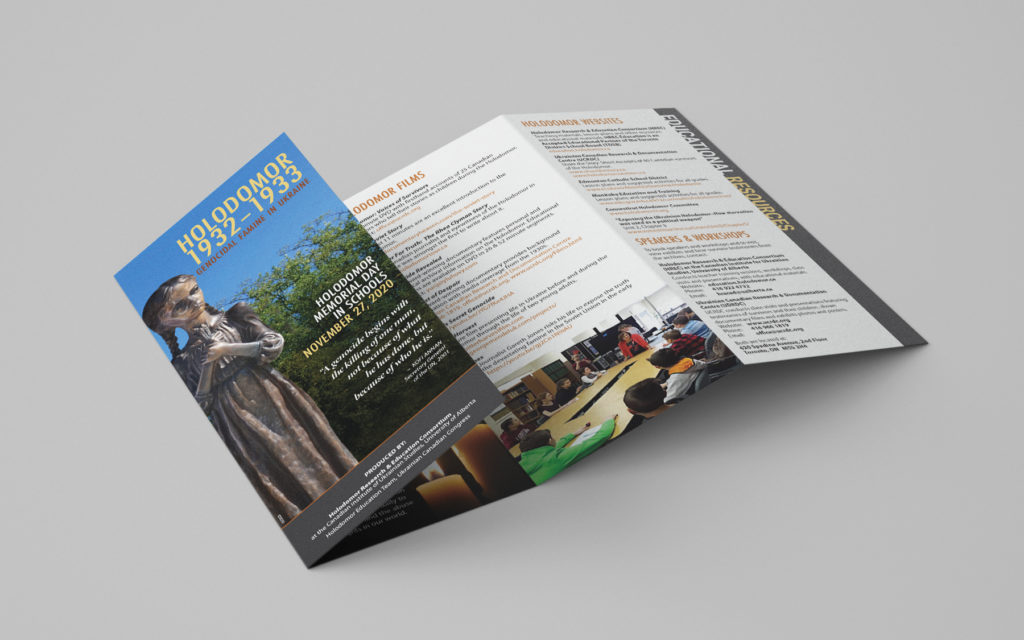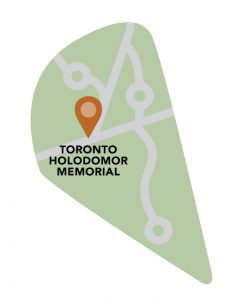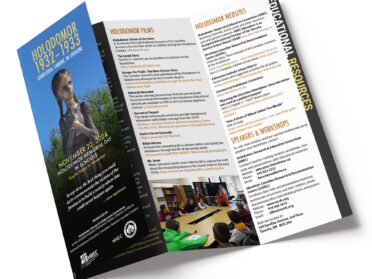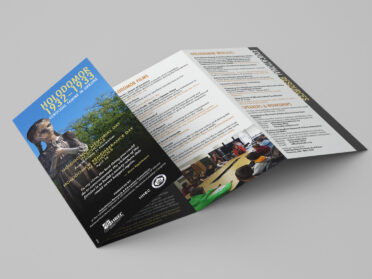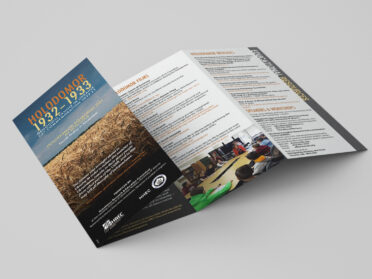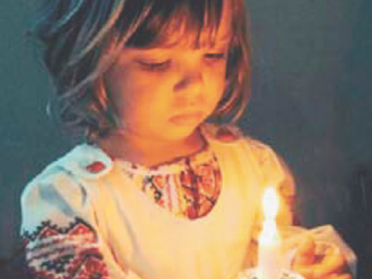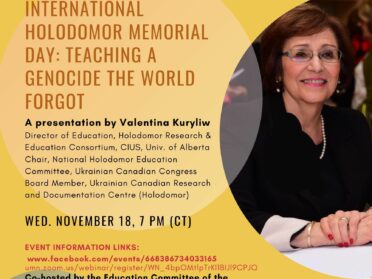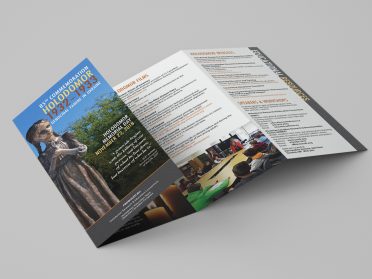Holodomor Memorial Day 2020
A downloadable educational pamphlet with teaching resources to use for Holodomor Memorial Day
Holodomor Memorial Day is commemorated each year on the fourth Friday of November in schools as a Day of Remembrance when we remember the millions of Ukrainians who were starved to death in Ukraine in 1932 and 1933, many of whom were children.
Through Acts of Parliament, the Government of Canada recognizes The Holodomor as an act of genocide. Together with the descendants of survivors living in Canada, let us remember the victims of the Holodomor.
 Loading...
Loading...
Holodomor Memorial Day – November 27, 2020
A genocide begins with the killing of one person, not because of what he has done, but because of who he is.
Holodomor Memorial Day in Schools: the 4th Friday of November
On the 29 May of 2008, the Parliament of Canada unanimously passed an “Act to Establish a Ukrainian Famine and Genocide (Holodomor) Memorial Day and to Recognize the Ukrainian Famine 1932-1933 as an Act of Genocide.” As a result of the advocacy of the Holodomor Education Team (UCC-Toronto) and later the National Holodomor Education Committee (NHEC), in 2008, the Toronto District School Board passed a resolution to hold an annual Holodomor Memorial Day in schools on the fourth Friday of November. Since then, other school boards across the country have followed suit. Each year for this event, the National Holodomor Education Committee (NHEC) and increasingly HREC Education, prepare an information pamphlet to help educators commemorate this day in their schools.
Worldwide, outside of schools, Holodomor Memorial Day is on the 4th Saturday of November.
Basic Facts About The Holodomor
- The Famine was perpetrated by the government of the Soviet Union against the population of Ukraine.
- Stalin issued a series of policies that led to genocide by starvation in Ukraine.
- The Holodomor occurred in a time of peace, not as a result of war or natural disaster.
- Food was used as a weapon.
- Wheat and other grains were confiscated from farmers by the Communist government. Some of it was sold for export to fund Stalin’s Five-Year Plan.
- The Holodomor was denied, covered up and ignored by the world for over 5 decades.
- Millions of innocent people died.
- 28,000* people died per day at the height of the Holodomor in June of 1933.
- 31% of those who died were children under the age of 10.
- The cultural, religious and political leadership of Ukraine was largely destroyed by imprisonment, deportation and executions during the 1930s.
* according to the latest research
Prepared by the Holodomor Research and Education Consortium and the Holodomor Education Team of the Ukrainian Canadian Congress.
The Toronto District School Board has prepared two teaching units on the Holodomor for the World History and World Politics Grade 12 courses (2009). It is available to school boards upon request.
Memorial Day Announcement
Today we remember the victims and survivors of one of the darkest chapters in human history. In 1932 and 1933, under the leadership of Joseph Stalin, the Soviet Union deliberately created a devastating famine in Ukraine. At least 4 million people died of enforced starvation during the Holodomor, meaning extermination by starvation.
Canada designates the 4th Friday and Saturday in November as Holodomor Memorial Day to commemorate the Ukrainian genocide. It is remembered as an attack on Ukrainian identity and culture. 85% of the Ukrainian population were village farmers who were targeted for destruction. Brigades of Communist activists were ordered to go from house to house in the villages to confiscate grain and all other foodstuffs to fulfill impossibly high grain quotas imposed by the Soviet government. They even used special metal rods to probe the ground and potential hiding places where they suspected grain could be hidden. Beginning in 1933, measures were additionally introduced to stop Ukrainian farmers from leaving their villages in search of food. This condemned millions of people in Ukraine to a slow and agonizing death by starvation.
The results were devastating. In the world’s most fertile farmland, nothing was left to eat. People caught rats, frogs, earthworms, made tree bark pancakes and pinecone soup, ate grass and roots. Meanwhile, grain stocks and other food taken from the villages were exported to pay for Stalin’s Five Year Plan of industrialization. Some grain rotted by the ton within sight of families starving to death. Those who resisted were shot, sent to the gulag, robbed or thrown out of their homes. Even children were executed for trying to pick up a few loose stalks of grain in the fields. 28,000 people died per day at the height of the Famine in June of 1933. 31% were children under the age of 10.
Let us take a moment to remember the victims of the Holodomor. Let us also reflect on the actions we can take daily in our school and our communities to combat genocide and the abuse of human rights in our world.
Educational Resources
Holodomor: Voices of Survivors
A 30 minute DVD with firsthand accounts of 25 Canadian survivors who tell their stories as children during the Holodomor.
Contact: office@ucrdc.org
The Soviet Story
The first 11 minutes are an excellent introduction to the Holodomor.
www.sovietstory.com
Hunger For Truth: The Rhea Clyman Story
The Canadian journalist and eyewitness of the Holodomor in Ukraine was amongst the first to write about it.
www.holodomortour.ca
Genocide Revealed
This award-winning documentary features personal and historical archival information on the Holodomor. Educational versions are available on DVD in 26 & 52 minute segments.
Contact: yurij@yluhovy.com
Harvest of Despair
This award-winning documentary provides background information with media coverage from the 1930s.
Ukrainian Canadian Research and Documentation Centre 416-966-1819, office@ucrdc.org, www.ucrdc.org/Films.html
Stalin’s Secret Genocide
Provides reflections from Holodomor researchers on various aspects of the story in a 15 minute overview.
www.holodomortour.ca
Bitter Harvest
A feature film presenting life in Ukraine before and during the Holodomor through the life of two young adults.
www.bitterharvestfilm.com
http://georgemendeluk.com/projects/
Mr. Jones
Holodomor Research & Education Consortium (HREC)
Teaching materials, lesson plans and other resources and educational materials.
education.holodomor.ca
Ukrainian Canadian Research & Documentation Centre (UCRDC)
Share the Story: Short excerpts of 80 Canadian survivors of the Holodomor.
www.sharethestory.ca
www.holodomorsurvivors.ca
Edmonton Catholic School District
Lesson plans and suggested activities for all grades.
www.ecsd.net/AboutUs/Overview/Holodomor
Manitoba Education and Training
Lesson plans and suggested activities for all grades.
www.edu.gov.mb.ca/k12/cur/multic/holodomor.html
Connecticut Holodomor Committee
“Exposing the Ukrainian Holodomor–How starvation was used as a political weapon”
Unit 2, Chapter 5
www.voicesintoaction.ca/Learn/Unit2/Chapter5/
To book speakers and workshops and to visit, view exhibits and hear survivor testimonies from the archives, contact:
Holodomor Research & Education Consortium (HREC)
Prepares educational materials. Conducts teacher training sessions, workshops, class visits and presentations.
Website: education.holodomor.ca
Phone: 416 923 4732
Email: hreced@ualberta.ca
Ukrainian Canadian Research & Documentation Centre (UDRDC)
UCRDC conducts class visits and presentations featuring testimonies of survivors and their children, shows documentary films and exhibits photos and posters.
Website: www.ucrdc.org
Phone: 416 966 1819
Email: office@ucrdc.org
Both are located at: 620 Spadina Avenue, 2nd Floor Toronto, ON M5S 2H4
Holodomor In Ukraine,
The Genocidal Famine: 1932-1933
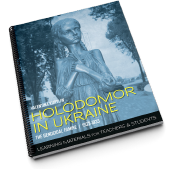
by V. Kuryliw, Edmonton: CIUS Press, 2018
Teaching materials, lesson plans and assignments with straightforward, sensible and basic information about the Famine. The book is accessible, instantly useable and packed with ideas and photocopiable resources.
Contact: hreced@ualberta.ca
Red Famine: Stalin’s War On Ukraine
by A. Applebaum, NY: Doubleday Books, 2017 An authoritative book on the Ukrainian genocide based on the most recent research.
The Holodomor Reader
by B. Klid & A. Motyl, Edmonton: CIUS Press, 2012 A collection of key texts and materials.
www.ciuspress.com/catalogue/history/324/the- holodomor-reader
Stalin’s Genocides
by N. Naimark, Princeton, NJ: Princeton University Press, 2010
Features the Holodomor and other genocides of the Soviet period.
Bloodlands: Europe Between Hitler and Stalin
by T. Snyder, New York: Basic Books, 2010
One major chapter specifically on the Holodomor.
Holodomor of 1932-1933 in Ukraine: Documents and Materials
by R. Pyrih, Kyiv: Kyiv-Mohyla Academy Publishing House, 2008
73 archival documents with correspondence about the Holodomor.
Print copies: hreced@ualberta.ca
E-version: education.holodomor.ca/educational- resources-list/pyrih-documents/
The Holodomor Mobile Classroom
 Take students beyond the textbook.
Take students beyond the textbook.
An innovative educational tool featuring a state of the art, interactive mobile learning space to educate students across Canada about the Holodomor.
Accommodating 33 students, the HMC features a 60-minute facilitator-led immersive learning experience with thought- provoking videos on the Holodomor and interactive learning activities that promote social responsibility and global awareness. The program supports teachers in meeting provincial curriculum expectations while promoting 21st century skills – including digital literacy and critical thinking.
Students leave empowered to protect Canadian values of freedom and democracy.
To book the Holodomor Mobile Classroom
Holodomor National Awareness Tour
Website: www.holodomortour.ca
Phone: 416 966 9800
Email: Holodomor.tour@cufoundation.ca
Toronto Holodomor Memorial
![]() Unveiled in October 2018 for the 85th Commemoration of the Holodomor in Ukraine, the Bitter Memories of Childhood monument is by sculptor Petro Drozdovsky.
Unveiled in October 2018 for the 85th Commemoration of the Holodomor in Ukraine, the Bitter Memories of Childhood monument is by sculptor Petro Drozdovsky.
Located just NE of the Princes’ Gate entrance of the Canadian National Exhibition (CNE) grounds, the memorial site includes pathways into a small park that progress through to a series of expressive contemplative symbols where students can learn about the Holodomor on their way to see this iconic sculpture.
Other Holodomor memorials in Canada may be viewed in Winnipeg, Edmonton and Regina.
April Is Genocide Remembrance, Condemnation, Prevention and Education Month
On April 24, 2015, the House of Commons unanimously passed a historic motion (M-587) to recognize the month of April as Genocide Remembrance, Condemnation and Prevention Month.
Canada has been affected by many genocides and recognizes: the Armenian Genocide, the Ukrainian Holodomor, the Jewish Holocaust, the Genocide Against the Tutsi in Rwanda and the Genocide in Bosnia. The Canadian Parliament has also recognized the ongoing genocide being committed against the Yezidi in Syria and Iraq today, the Rohingya in Myanmar and the Romani during WWII.
Educators are encouraged to take time in April to remember those who suffered and lost their lives in the Holodomor and other genocides, to commit to using education to protect and defend human rights and dignity everywhere, and to stand up against prejudice, hate and other forms of exclusionary practices that are known precursors to crimes against humanity.
Prepared by the Holodomor Research and Education Consortium and the Holodomor Education Team of the Ukrainian Canadian Congress.
The Toronto District School Board has prepared two teaching units on the Holodomor for the World History and World Politics Grade 12 courses (2009). It is available to school boards upon request.
All Memorial Day Posts
Holodomor Memorial Day Holodomor Memorial Day in Schools: the 4th Friday of November On the 29 May of 2008, the Parliament of Canada unanimously passed an “Act to Establish a Ukrainian Famine and Genocide (Holodomor) Memorial Day and to Recognize the U...
Continue Reading Holodomor Memorial DayHolodomor Memorial Day Holodomor Memorial Day in Schools: the 4th Friday of November On the 29 May of 2008, the Parliament of Canada unanimously passed an “Act to Establish a Ukrainian Famine and Genocide (Holodomor) Memorial Day and to Recognize the U...
Continue Reading Holodomor Memorial Day 2024Holodomor Memorial Day Holodomor Memorial Day in Schools: the 4th Friday of November On the 29 May of 2008, the Parliament of Canada unanimously passed an “Act to Establish a Ukrainian Famine and Genocide (Holodomor) Memorial Day and to Recognize the U...
Continue Reading Holodomor Memorial Day 2023Holodomor Memorial Day Holodomor Memorial Day in Schools: the 4th Friday of November On the 29 May of 2008, the Parliament of Canada unanimously passed an “Act to Establish a Ukrainian Famine and Genocide (Holodomor) Memorial Day and to Recognize the U...
Continue Reading Holodomor Memorial Day 2022Holodomor Memorial Day – November 26, 2021 Holodomor Memorial Day in Schools: the 4th Friday of November On the 29 May of 2008, the Parliament of Canada unanimously passed an “Act to Establish a Ukrainian Famine and Genocide (Holodomor) Memorial ...
Continue Reading Holodomor Memorial Day 2021Nov 1–Nov 31 Holodomor: A Remembrance. A Virtual Visual Art Presentation, Featuring Works by Lydia Bodnar-Balahutrak of Houston, TX. Developed by the virtual exhibition team Roksolana Karmazyn, Chrystia Bryndzia, Ksenia Rychtycka, Anizia Karmazyn, and O...
Continue Reading Upcoming November 2020 Holodomor Memorial EventsMINNEAPOLIS, MN – on November 18, 2020, the Center for Holocaust and Genocide Studies (CHGS) at the University of Minnesota and the Ukrainian American Community Center (UACC) of Minneapolis invited author, educator and advocate of Holodomor teaching and...
Continue Reading In commemoration of International Holodomor Memorial Day: Teaching a Genocide the World ForgotHolodomor Memorial Day – November 27, 2020 Holodomor Memorial Day in Schools: the 4th Friday of November On the 29 May of 2008, the Parliament of Canada unanimously passed an “Act to Establish a Ukrainian Famine and Genocide (Holodomor) Memorial ...
Continue Reading Holodomor Memorial Day 2020Holodomor Memorial Day – November 22, 2019 Holodomor Memorial Day is November 22, 2019. For schools (4th Friday of November). Worldwide, Holodomor Memorial Day is November 23 (4th Saturday of November). Basic Facts About The Holodomor * accordi...
Continue Reading Holodomor Memorial Day 2019Holodomor Memorial Day – November 23, 2018 Holodomor Memorial Day is November 23, 2018. For schools (4th Friday of November). Worldwide, Holodomor Memorial Day is November 24 (4th Saturday of November). Basic Facts * according to the latest res...
Continue Reading In commemoration of the 85th anniversary of the Ukrainian Holodomor of 1932–1933, the Genocidal Famine in Ukraine